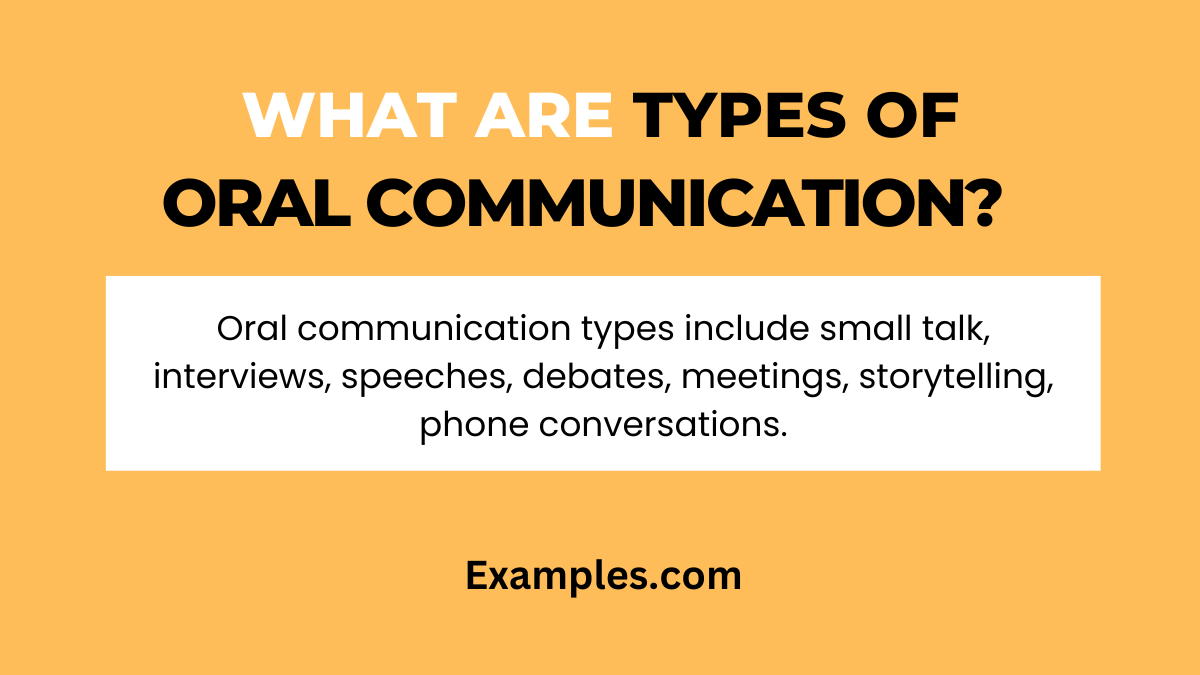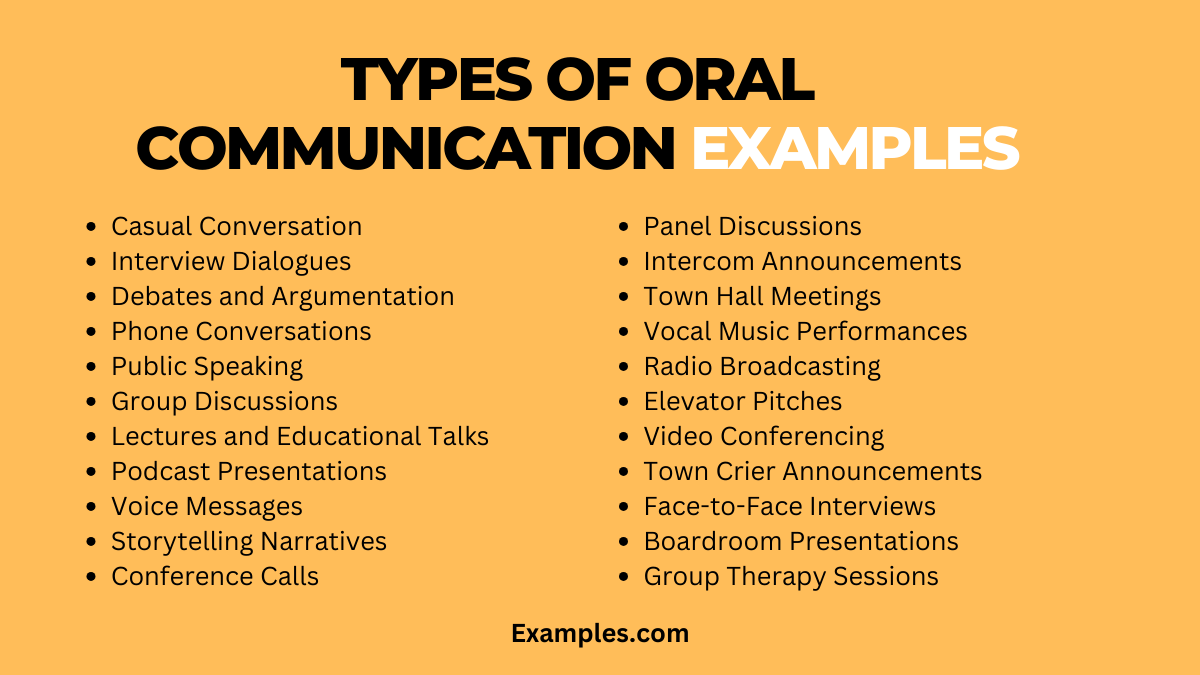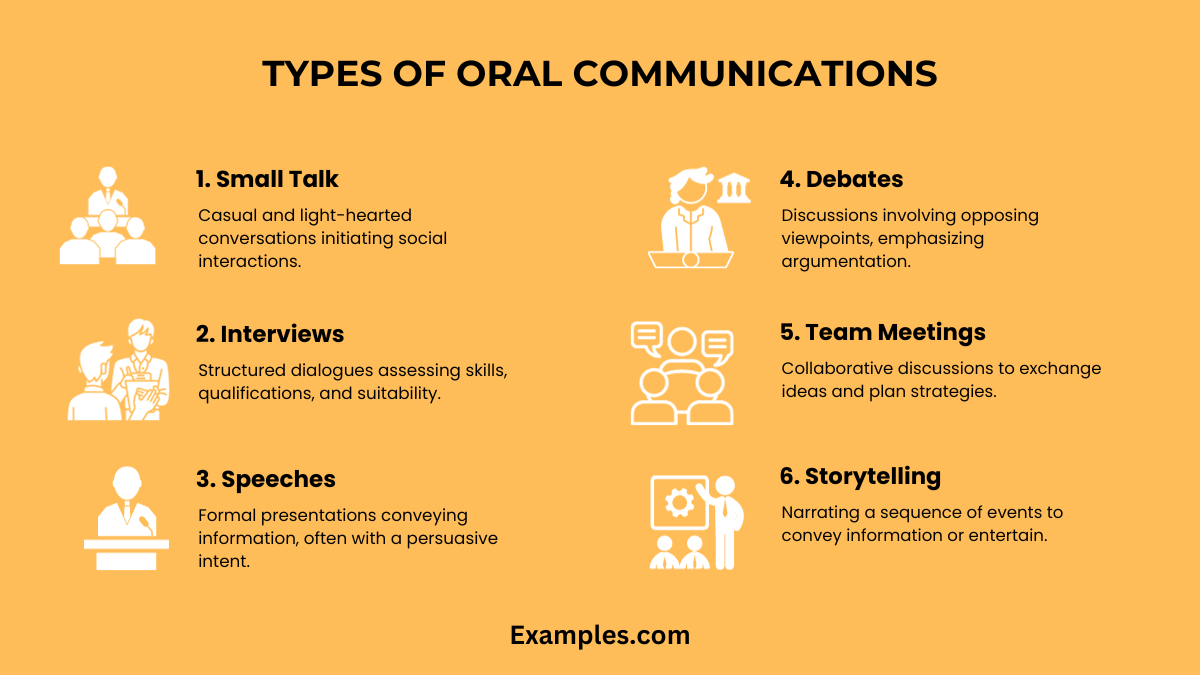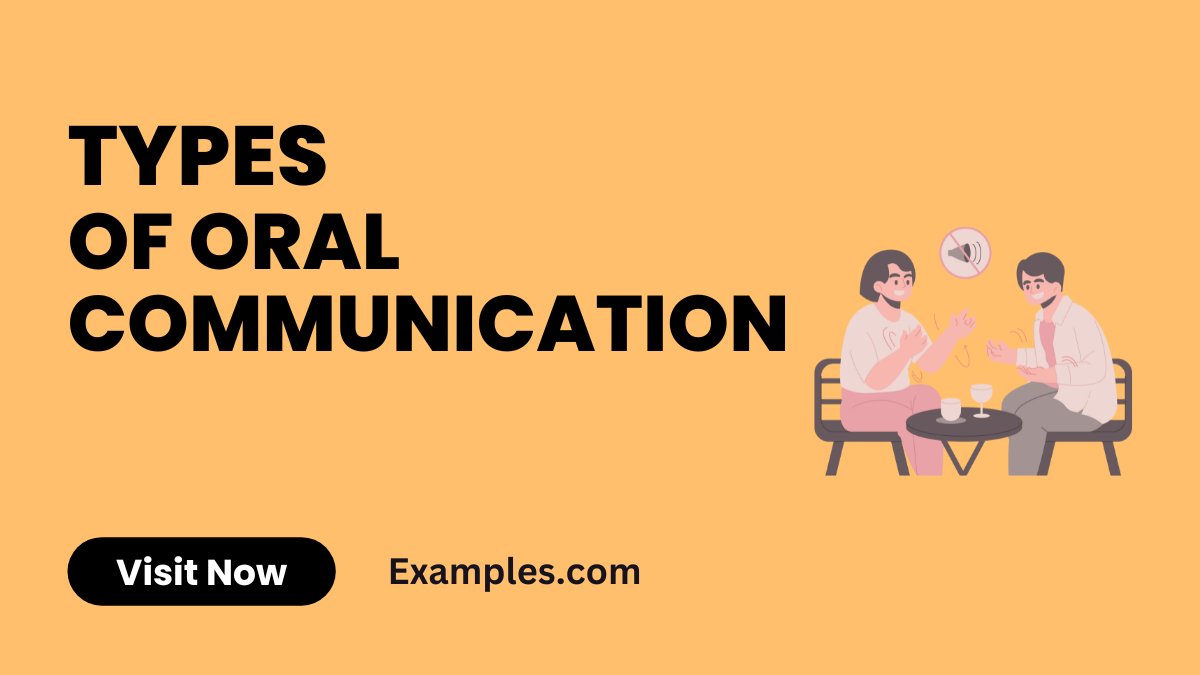29+ Types of Oral Communication Examples
Embark on a journey to unravel the intricacies of oral communication. Discover the varied types, nuances, and impactful examples that shape the way we convey thoughts, ideas, and emotions verbally. From everyday conversations to formal presentations, delve into the rich tapestry of oral communication and hone your skills for effective interaction.
What are Types of Oral Communication?

Types of oral communication encompass diverse verbal exchanges, ranging from casual discussions to structured presentations. In essence, it involves conveying information through spoken words, facilitating understanding and connection. Understanding these types is pivotal for navigating various social, professional, and personal scenarios.
30 Types of Oral Communication Examples

Explore a diverse array of oral communication examples, each showcasing unique characteristics and purposes. From everyday interactions to formal presentations, these examples illuminate the versatility of spoken communication, empowering individuals in various contexts.
- Casual Conversation: Engage in friendly chats, fostering connections through relaxed and informal dialogue.
- Interview Dialogues: Navigate structured Q&A sessions, showcasing skills and qualifications with confidence.
- Debates and Argumentation: Present and defend opinions persuasively in organized discussions.
- Phone Conversations: Convey messages verbally over the phone, ensuring clear and effective communication.
- Public Speaking: Address an audience confidently, delivering impactful speeches on diverse topics.
- Group Discussions: Collaborate with others, sharing ideas and perspectives in a collective setting.
- Lectures and Educational Talks: Conduct informative talks, imparting knowledge to an audience.
- Podcast Presentations: Broadcast spoken content digitally, engaging listeners on various subjects.
- Voice Messages: Send recorded spoken messages, adding a personal touch to digital communication.
- Storytelling Narratives: Convey narratives with vivid language, captivating listeners through compelling tales.
- Conference Calls: Participate in telephonic discussions with multiple participants, facilitating remote collaboration.
- Panel Discussions: Engage in group conversations, providing insights on specific topics as an expert.
- Intercom Announcements: Utilize intercom systems for internal communication within specific environments.
- Town Hall Meetings: Address large gatherings for community discussions, updates, and collaboration.
- Vocal Music Performances: Express emotions and stories through sung lyrics, connecting with audiences.
- Radio Broadcasting: Disseminate information and entertainment through spoken content on airwaves.
- Elevator Pitches: Deliver concise and impactful presentations within a short timeframe.
- Video Conferencing: Conduct virtual meetings with audio and visual components, enhancing remote interactions.
- Town Crier Announcements: Historical method of public communication in town squares or gathering places.
- Face-to-Face Interviews: Engage in personal interviews, showcasing interpersonal communication skills.
- Boardroom Presentations: Conduct formal presentations in corporate settings, conveying information to stakeholders.
- Client Meetings: Foster positive client relationships through structured and client-focused conversations.
- Team Collaboration Discussions: Exchange ideas and plan strategies collaboratively in team settings.
- Press Conferences: Handle media inquiries with professionalism, ensuring clear and accurate communication.
- Legal Consultations: Navigate legal discussions with precision and articulate argumentation.
- Public Address Systems: Use audio amplification to address large audiences in public spaces.
- Group Therapy Sessions: Conduct therapeutic conversations in group settings for collective support.
- International Business Discussions: Navigate cross-cultural conversations in global business scenarios.
- Scientific Research Presentations: Present research findings formally, simplifying complex information for diverse audiences.
- Human Resources Interviews: Conduct HR interviews with professionalism and adherence to organizational policies.
Types of Oral Communication Examples for Students
Unlock the diverse realm of oral communication tailored for students. From classroom discussions to presentations, students navigate various verbal exchanges to enhance their learning experience. Engage in effective communication for academic success and personal development.
- Classroom Discussions: Participate actively in class discussions, sharing insights and perspectives with classmates.
- Group Projects: Collaborate with peers on group projects, exchanging ideas and coordinating tasks for successful outcomes.
- Oral Presentations: Deliver informative speeches or presentations, enhancing communication and presentation skills.
- Debates: Engage in structured debates, articulating arguments and counterarguments with clarity.
- Student Meetings: Contribute to student council or club meetings, expressing opinions on relevant matters.
- Study Group Dialogues: Discuss academic topics within study groups, fostering a collaborative learning environment.
- Virtual Learning Interactions: Participate actively in online classes, utilizing verbal communication for virtual education.
- Peer-to-Peer Communication: Interact with classmates for study-related discussions, creating a supportive learning network.
- Informal Conversations: Build friendships through casual conversations, strengthening social bonds among students.
- Faculty Interactions: Communicate with instructors for clarification on coursework or academic guidance.
Types of Oral Communication Examples at Business
In the corporate landscape, effective oral communication is vital for success. Navigate business interactions, from professional presentations to client meetings, fostering clear and impactful communication within the organizational context.
- Boardroom Negotiations: Participate in negotiations during boardroom meetings, ensuring successful outcomes for the organization.
- Client Presentations: Conduct formal presentations to clients, showcasing products, services, and business solutions.
- Team Briefings: Communicate project updates and strategies during team briefings, ensuring alignment among team members.
- Sales Pitches: Deliver persuasive sales pitches to potential clients, emphasizing the benefits of products or services.
- Conference Calls: Participate in telephonic discussions with remote teams or clients, ensuring effective communication.
- Email Correspondence: Craft clear and concise emails for professional communication within and outside the organization.
- Performance Reviews: Engage in performance discussions, providing feedback and setting goals for employee growth.
- Leadership Presentations: Conduct presentations as a leader, inspiring and aligning teams with organizational goals.
- Business Networking: Build professional connections through formal conversations during networking events.
- Crisis Management Communication: Navigate crisis situations by communicating effectively with stakeholders and the public.
Types of Oral Communication Examples at Home
Oral communication plays a crucial role in fostering strong relationships within the home environment. From family discussions to casual conversations, effective verbal exchanges contribute to a harmonious home life.
- Family Meetings: Conduct family meetings to discuss important matters, fostering open communication within the household.
- Parent-Teacher Conferences: Engage in discussions with teachers about a child’s academic progress and development.
- Sibling Interactions: Communicate with siblings to resolve conflicts, share experiences, and build strong bonds.
- Casual Family Dinners: Engage in light-hearted conversations during family dinners, strengthening familial connections.
- Vacation Planning: Coordinate family vacations through effective communication, considering preferences and logistics.
- Household Chores Delegation: Assign and discuss household chores, ensuring a shared understanding of responsibilities.
- Celebration Planning: Coordinate and plan celebrations through family discussions, ensuring everyone’s involvement.
- Decision-Making Dialogues: Involve family members in decision-making processes, encouraging open communication.
- Expressing Gratitude: Verbalize appreciation and gratitude within the family, reinforcing positive communication.
- Daily Check-ins: Engage in daily check-ins with family members, fostering communication about individual experiences and concerns.
Types of Oral Communications

Oral communication encompasses a rich tapestry of forms, each serving distinct purposes in various settings. Explore the nuanced types, ranging from casual dialogues to formal presentations, in this comprehensive guide.
| Types of Oral Communication | Description |
|---|---|
| Small Talk | Casual and light-hearted conversations initiating social interactions. |
| Interviews | Structured dialogues assessing skills, qualifications, and suitability. |
| Speeches | Formal presentations conveying information, often with a persuasive intent. |
| Debates | Discussions involving opposing viewpoints, emphasizing argumentation. |
| Team Meetings | Collaborative discussions to exchange ideas and plan strategies. |
| Storytelling | Narrating a sequence of events to convey information or entertain. |
| Phone Conversations | Verbal exchanges conducted over the telephone. |
| Video Conferencing | Virtual meetings facilitated by audio and visual technology. |
Mention the Elements Types for Oral Communication?
Understanding the key elements of oral communication forms the foundation for effective interaction. Elements such as clarity, tone, and nonverbal cues significantly influence the impact of verbal exchanges.
- Clarity: Ensure your message is clear and easily comprehensible to the audience.
- Tone: Adapt your tone to suit the context, fostering a conducive communication environment.
- Nonverbal Cues: Be mindful of body language, gestures, and facial expressions, as they convey additional meaning.
- Active Listening: Engage in active listening, demonstrating attentiveness and understanding.
- Empathy: Understand and consider the emotions of the speaker or audience to foster connection.
- Conciseness: Express ideas succinctly, avoiding unnecessary elaboration for better retention.
- Adaptability: Adjust communication style based on the audience, context, or purpose.
- Feedback: Encourage and provide feedback to enhance the effectiveness of the communication process.
Tips for Effective Types of Oral Communication
Mastering the art of oral communication requires honing specific skills and adopting effective strategies. Employ these tips to enhance your verbal exchanges in various scenarios.
- Practice Active Listening: Cultivate the habit of listening attentively, promoting meaningful and engaged conversations.
- Refine Your Articulation: Enhance clarity by articulating words and ideas clearly, avoiding jargon or ambiguity.
- Adapt to Your Audience: Tailor your communication style to resonate with the expectations and preferences of your audience.
- Utilize Visual Aids: Incorporate visuals when appropriate to complement verbal messages and enhance understanding.
- Manage Nonverbal Cues: Be conscious of your body language, facial expressions, and gestures to convey the intended message.
- Be Concise and Relevant: Express ideas succinctly, ensuring that your message is focused and directly addresses the topic.
- Seek and Provide Feedback: Invite feedback for continuous improvement, and offer constructive feedback to others.
- Consider Cultural Sensitivity: Adapt your communication to be culturally sensitive, recognizing and respecting diverse norms.
- Stay Calm Under Pressure: Develop resilience to communicate effectively even in high-pressure situations.
- Continuously Develop Communication Skills: Invest in ongoing learning and training to refine and expand your oral communication skills.
In conclusion, the vast and varied landscape of oral communication is fundamental to our interactions across different facets of life. This dynamic mode of communication is not only about conveying information but also about building relationships and understanding. The richness of oral communication lies in its ability to adapt to diverse contexts – from casual conversations to formal speeches, each form has its unique impact and significance.
Moreover, the effectiveness of oral communication hinges on key elements like clarity, tone, and nonverbal cues, as well as on practiced skills such as active listening, articulation, and cultural sensitivity. By continuously developing these skills, one can significantly enhance their oral communication abilities, ensuring messages are not only heard but also understood and appreciated in their intended context.
For further exploration, Harvard University offers insightful resources on the nuances of effective communication in different settings, which can be found at Harvard’s Division of Continuing Education blog. Additionally, the University of Oxford provides valuable guidelines on developing oral communication skills, particularly in academic and professional environments, accessible at Oxford’s MPLS Division website. These external resources are excellent for delving deeper into mastering the art of oral communication.



